Milankovitch cycles are periodic changes in the orbital characteristics of a planet that control how much sunlight it receives, thus affecting its climate and habitability over hundreds of thousands of years.
Although Milankovitch cycles have nothing to do with the current climate change, they are believed to have dictated Earth‘s climate for millions of years, making the planet swing periodically between tens to hundreds of thousands-year long ice ages and warmer periods called interglacials, such as the one we live in.
Today, scientists can model Earth’s Milankovitch cycles millions of years into the past and future and compare their calculations with evidence found in geological sediments all over the world. Some believe that Milankovitch cycles play a key role in the habitability of planets.
Related: What will the Earth be like in 500 years?
What drives the Milankovitch cycles?
The amount of sunlight that reaches the outer atmosphere of our planet depends on three parameters: the tilt of Earth’s axis toward the plane in which the planet orbits, the eccentricity of its orbit (how elliptical the orbit is), and the so-called precession of the planet’s axis (as Earth spins, its axis slightly wobbles, pointing in different directions over time, like a spinning toy top).
These parameters are influenced by the gravitational forces of other planets in the solar system, the pull of the sun as well as Earth’s moon. Each of these parameters changes with a different frequency, but since astronomers know the orbit of our planet and its neighbors with great precision, they can calculate the Milankovitch cycles hundreds of millions of years into the past as well as into the future.
Orbital eccentricity
(opens in new tab)
Among the planets of the solar system, Earth’s orbit is among the most circular. However, this has not always been the case and it will change again in the future. These changes are mostly driven by the gravitational pull of Jupiter and Saturn, according to NASA (opens in new tab), and affect the length of our seasons.
With a nearly circular orbit, the length of the seasons is about equal, but as the orbit becomes more elliptical, the length of the seasons will start to vary. Over long periods of time, this can trigger profound climate changes.
“The total change in global annual insolation due to the eccentricity cycle is very small,” Alberto Maliverno, a geophysics professor at Columbia University in New York told Space.com. “It is a very minor factor in annual seasonal climate variations. But it starts making a difference over long timescales.”
Currently, Earth reaches its closest point to the sun, the so-called perihelion, in early January, during the Southern Hemisphere’s summer, and the aphelion, the farthest point from the sun, in early July. The difference in the distance of the planet to the star in those two points is about 3.2 million miles (5.1 million kilometers), according to NASA, which is only about 3.5% of the average sun-Earth distance. As a result, 6.8% more sunlight hits Earth’s atmosphere every January than it does each July. But the short-term effect on climate is negligible.
However, when the planet’s orbit reaches its most elliptical stage, about 100,000 years from now, that difference will result in 23% more sunlight reaching Earth’s atmosphere around perihelion, NASA said. Overtime, this difference could trigger profound changes in Earth’s climate.
Changes to the tilt of Earth’s axis (obliquity)
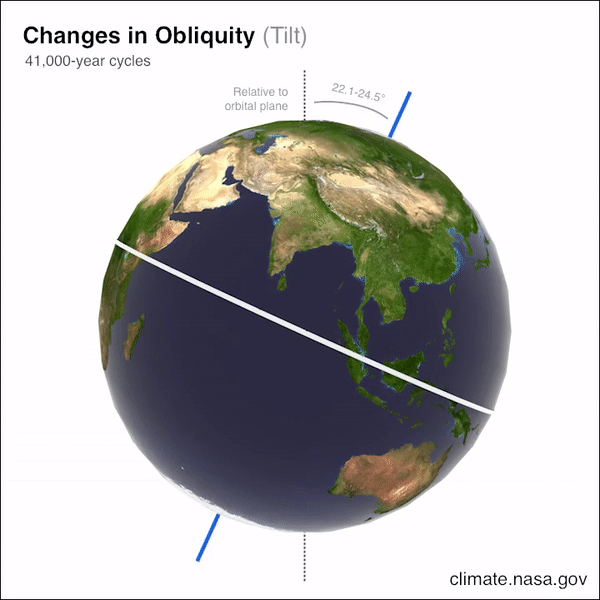
(opens in new tab)
Our planet spins on an axis that is tilted toward the orbital plane. Currently, this tilt (also called obliquity) deviates by 23.4 degrees from what would be a 90-degree angle toward the orbital plane. But this obliquity oscillates over time. Over the last million years, it has been swinging from 22.1-degrees to 24.5-degrees, according to NASA.
During more tilted periods, the seasons on Earth get more extreme, as each hemisphere receives more sunlight in summer, when it’s tilted toward the sun, and less in winter when it’s tilted away.
Over time, the longer winters lead to the expansion of polar ice caps and continental ice sheets. At the peak of ice ages, most of Earth’s land could be covered in ice, the planet turning into an inhospitable snowball. These swings of the tilt of Earth’s axis happen about every 40,000 years, said Maliverno.
Precession
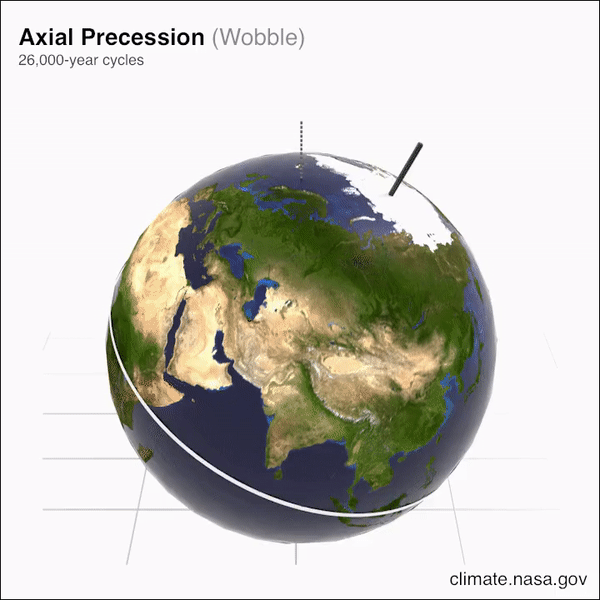
(opens in new tab)
As Earth spins, its axis wobbles in a circle . This effect is called axial precession. As a result, in our era, the axis points in the North toward the star Polaris, which is known as the North Star. But in a few thousand years, it will point to the star Kochab in the constellation Little Dipper, according to NASA. It takes 25,772 years for the axis to complete a full circle.
Axial precession makes seasonal contrasts more extreme in one hemisphere and less extreme in the other, NASA said. This effect combines with the precession of the planet’s orbit. Essentially, not just the axis of Earth’s rotation wobbles, but so does the whole plane, in which the planet travels around the sun. As a result, the closest and farthest points of the planet’s orbit to the star are not fixed, but move over time. Right now, perihelion happens during the southern summer, but in about 13,000 years, it will be the Northern Hemisphere that will be closer to the star in the summer months.
Who discovered the Milankovitch cycles?
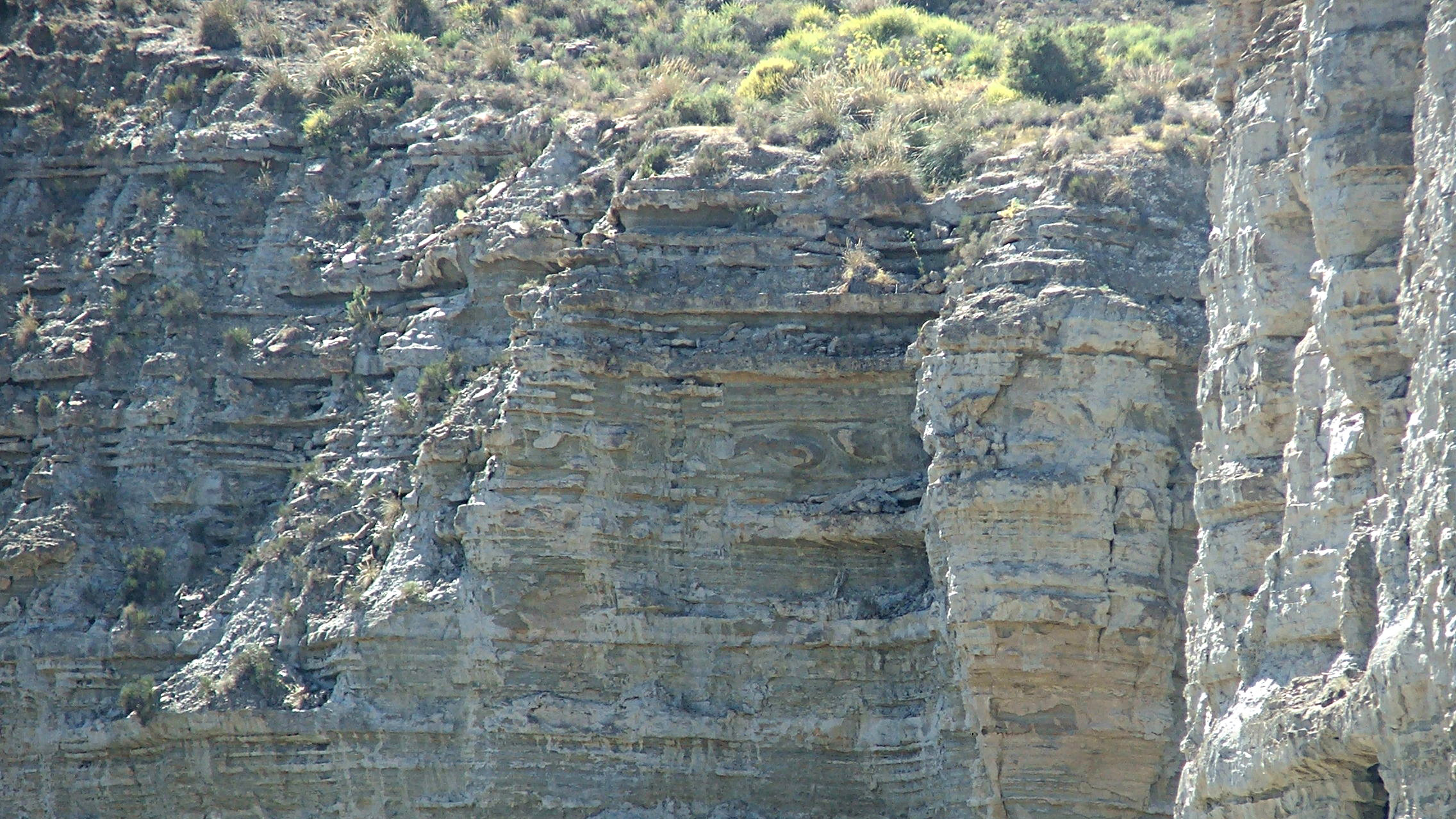
Milankovitch cycles are named after Serbian mathematician and astronomer Milutin Milankovitch, who first came up with the theory that past fluctuations in Earth’s climate, the evidence of which scientists can see in geological sediments, were caused by changes in the amount of sunlight reaching the planet.
Milankovitch calculated those cycles back 600,000 years including the amount of sunlight reaching Earth’s upper atmosphere, arguing that those changes were responsible for the periodic swings between the ice ages and the warm interglacials.
“The calculations of Earth’s history of the Milankovitch cycles have gotten better and better, and more accurate,” Russell Deitrick, a postdoctoral researcher in planet habitability at Bern University in Switzerland, told Space.com. “There is still a debate around what exactly is the response of the climate to the Milankovitch cycles and whether they are solely responsible for the ice ages.”
Milankovitch cycles and Earth’s ice ages
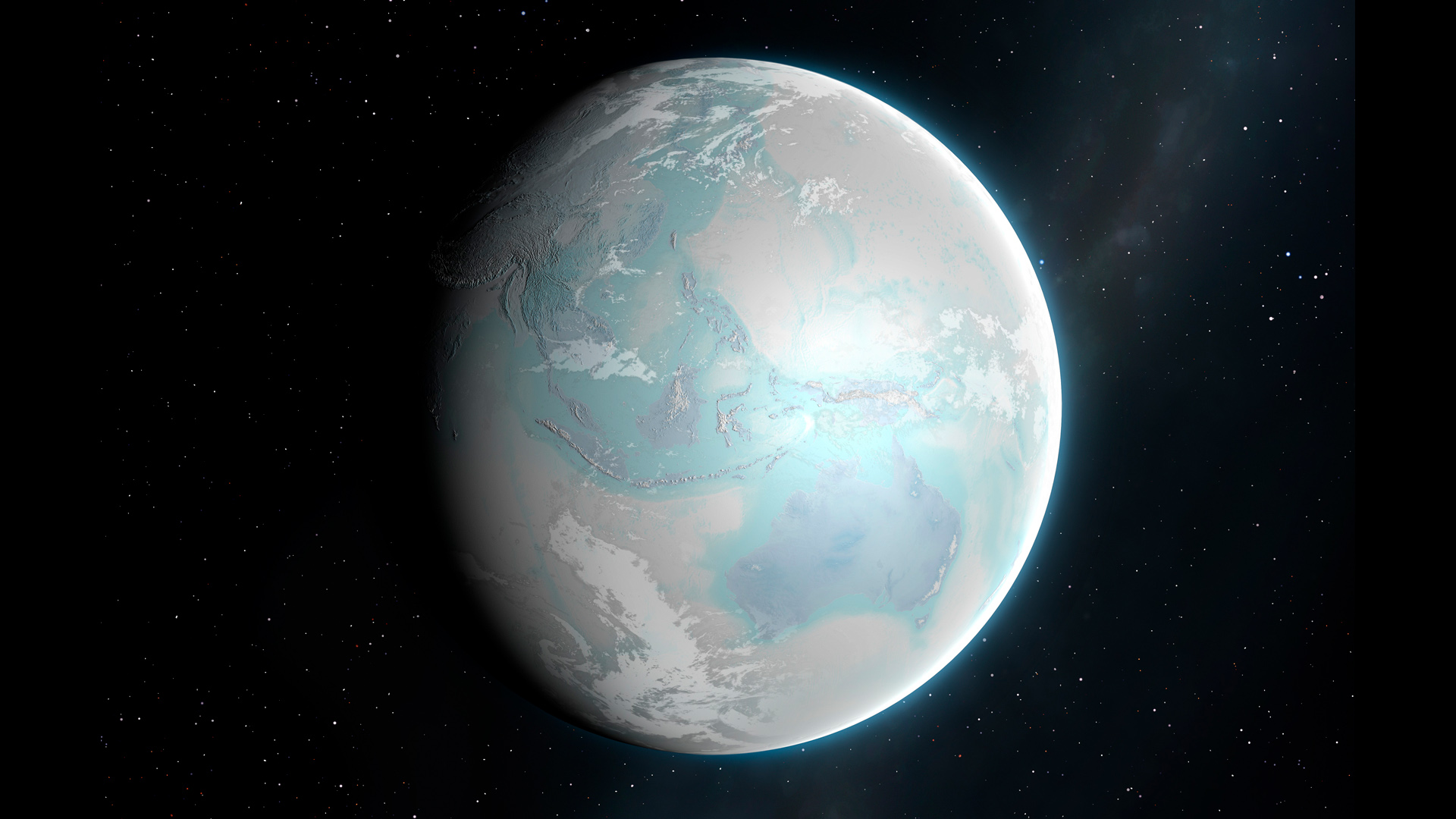
The most significant proof that Milankovitch cycles dictate Earth’s climate is the fact that the astronomical calculations match what geologists see when they date layers of sediments found in areas which in the past formed the bed of the ocean.
“We know that the Milankovitch cycles affected glaciation because we can see that clearly in geological records,” said Maliverno. “At the bottom of the oceans, there is always some sediment that slowly deposits. When you have a period when it rains more, for example, because of changes in the global circulation, there will be more erosion and more sediment of a certain type. When the climate becomes drier, you will get a different type of sediment. That’s how these sediments record climate change.”
Thanks to such excavations, scientists know that in the past 2.4 billion years Earth experienced at least five major ice ages, according to Utah Geological Survey (opens in new tab). The last ice age peaked about 20,000 years ago, during the Pleistocene epoch, a period that lasted from 2.6 million to 11,700 years ago (opens in new tab). At the height of the last ice age, as wooly mammoths roamed vast ice sheets covering North America and Eurasia, global temperatures were about 10 degrees Fahrenheit (5 degrees Celsius) colder than today (opens in new tab).
Do Milankovitch cycles have anything to do with the current climate change?

Climate change deniers like to argue that our planet would warm up no matter what, even without the greenhouse gas emissions that humankind is releasing into Earth’s atmosphere.
Maliverno, however, says that the geological record doesn’t suggest that this would be the case.
“There have been several campaigns in the past when researchers drilled into the Antarctic ice sheets and took samples from deep below the surface, reaching layers that are up to 800,000 years old,” Maliverno said. “They analyzed the concentrations of carbon dioxide trapped in those layers. There are tiny air bubbles in the ice, essentially samples of the atmosphere as it was back then, and they found that even during the interglacials, the maximum amount of carbon dioxide was nowhere near the amount that we see today.”
Moreover, Maliverno added, computer modeling studies that tried to reproduce the current climate change using only natural variables, such as the Milankovitch cycles, couldn’t match the rate of warming we see today.
When will be the next ice age?
Still, even without the current man-made climate change, the planet would be set for some serious climate havoc at some point in the future. That point in time, however, wouldn’t come for tens of thousands of years. The next ice age, Maliverno said, could be expected about 50,000 years from now. But what happens with the climate in the next decades might set us up for a much earlier climate mayhem.
“In the last 10,000 years ago, we have had an amazingly constant climate,” said Maliverno. “Agriculture could only start during the interglacial. That’s when human civilization flourished. But we’re messing with the climate and really changing this very even plateau that we have enjoyed for the last few millennia,” Maliverno said.
What do Milankovitch cycles have to do with the habitability of planets?
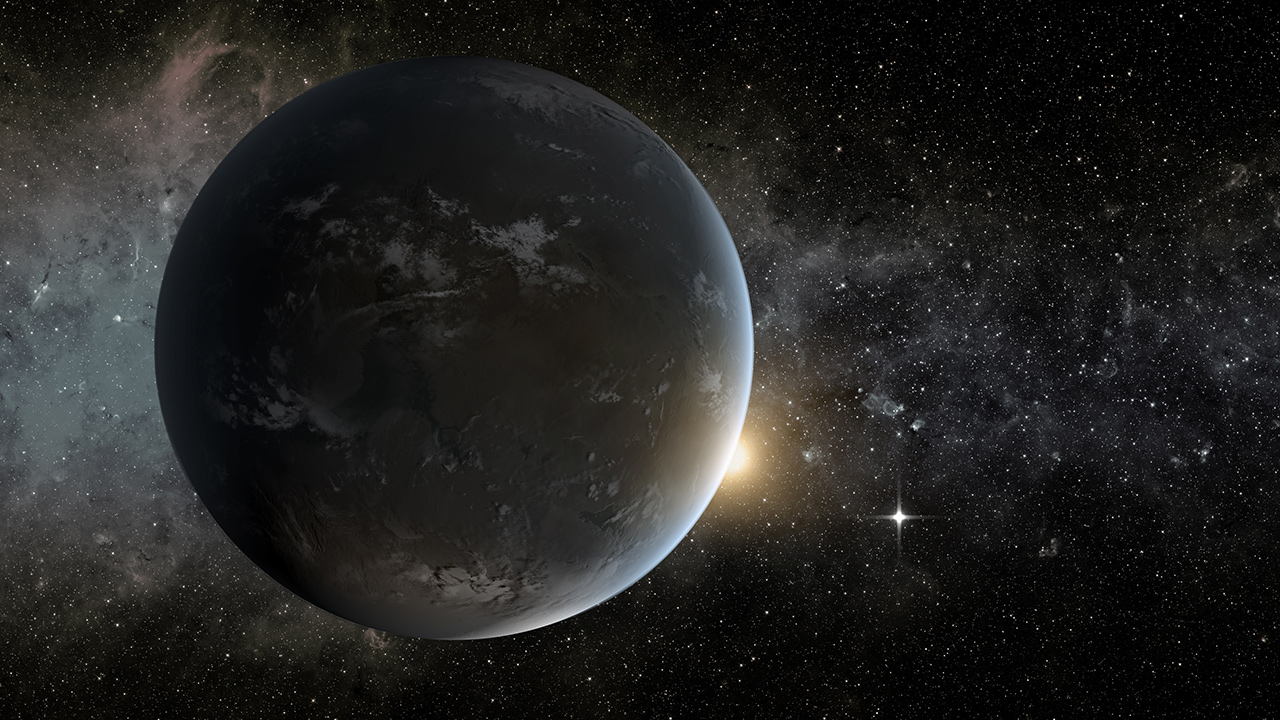
Scientists think that life on Earth as we know it could only spring into existence thanks to the rather mild nature of the planet’s Milankovitch cycles.
Russell Deitrick models the habitability of exoplanets based on their Milankovitch cycles. He believes that being in the so-called habitable zone, a region around the central star where liquid water can exist, is not enough for an Earth-like planet to host life. However, how exactly Milankovitch cycles affect habitability is not clear.
“Some studies have found that having strong Milankovitch cycles, particularly having large obliquity changes, might actually be a good thing for habitability,” said Deitrick. “It might prevent the planet from entering the snowball state. In my study (opens in new tab) [from 2018], I found, however, the exact opposite. I found that with large obliquity changes, you might have super large ice sheets building up on land, which are basically permanent and very difficult to get rid of as they introduce thermal inertia.”
Deitrick thinks that the more pronounced the Milankovitch cycles, the less habitable a planet could be. The models, he said, are, however, still rather crude.
“To understand the Milankovitch cycles of an exoplanet, we need to have really good measurements of the orbital parameters of the planet that we’re looking at, but also all the orbital parameters of all the other planets in the system,” said Deitrick. “Milankovitch cycles are a complex thing that is caused by perturbations from all the other planets in the system and perturbations from the host star and any moons that the planet might have.”
The only planet apart from Earth that scientists have enough information about to analyze its Milankovitch cycles and their effect on climate, is Mars.
“Mars undergoes Milankovitch cycles that are much more extreme [than those of Earth],” said Deitrick. “Its obliquity changes by much larger amounts than Earth’s and its eccentricity changes by larger amounts than Earth’s.”
Measurements of polar deposits conducted by orbiters scanning the red planet show alternating layers of ice and dust that testify to the periodically changing temperatures in Mars’ polar regions throughout the eons, Deitrick said.
What does the moon have to do with Earth’s Milankovitch cycles?
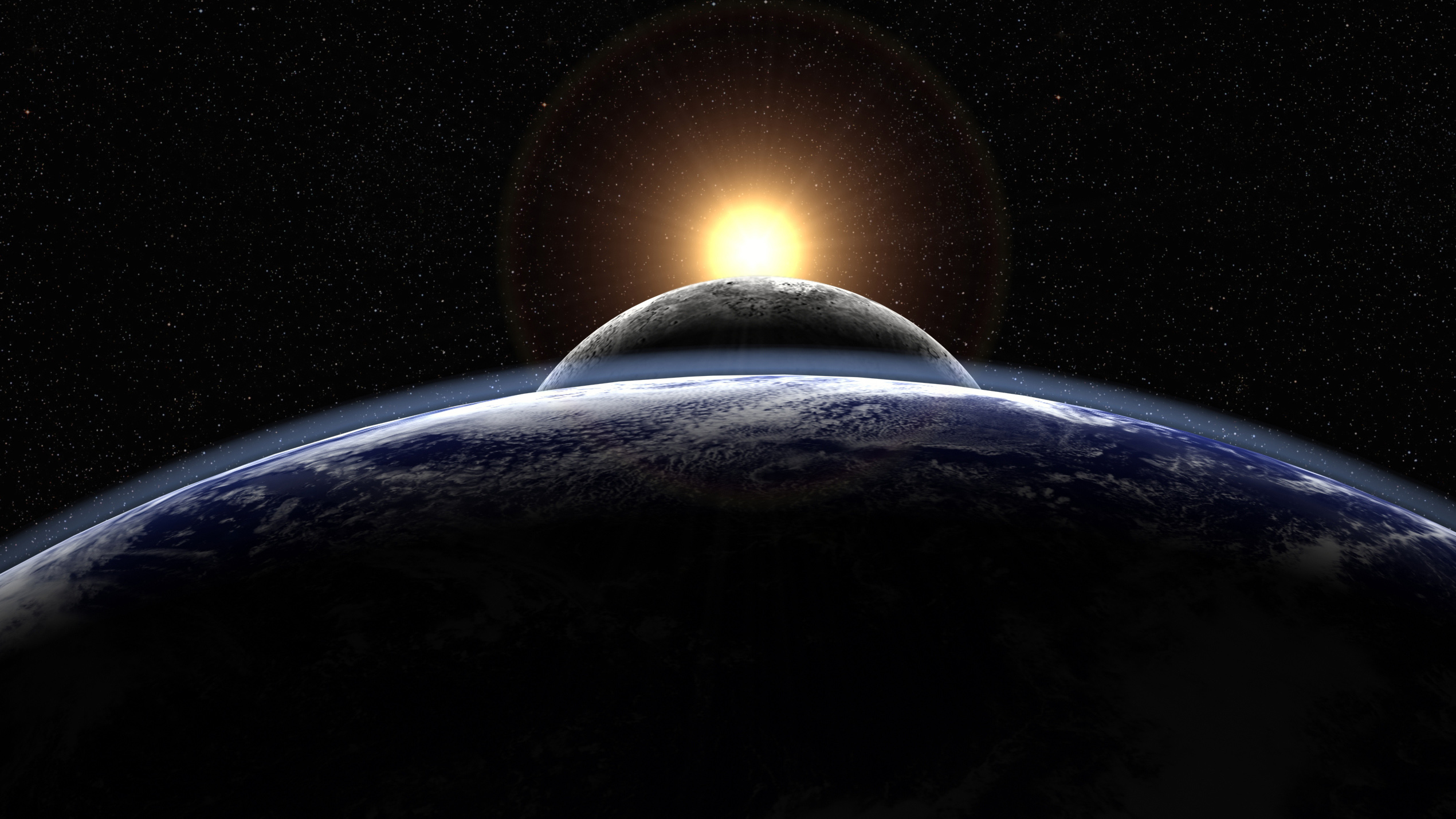
The Earth’s climate would likely be far less life-friendly if it weren’t for the planet’s large moon. Some scientists think that without the moon, life on Earth may not be possible at all.
This theory was put forward by astrobiologist Peter Ward and evolutionary biologist Donald Brownle in their book Rare Earth (opens in new tab), published in 2000.
The two postulate that the large and massive moon creates a torque on Earth’s equatorial bulge, the widening of the planet around the equator, which stabilizes the precession of the planet’s axis. Ward and Brownle claim that without the moon, the Earth’s axis would oscillate by up to 30 degrees, causing much more pronounced climate fluctuations.
Deitrick, however, cautions that this theory has not been proven.
Unanswered questions about Milankovitch cycles
Despite the advances in computer modeling, there are still some puzzling questions about the Earth’s changing climate and the Milankovitch cycles. Geological records show that up to one and a half million years ago, Earth’s climate was changing with the periodicity of about 100,000 years, said Maliverno. Such fluctuations would correspond to the changes in the eccentricity of Earth’s orbit.
Older sediments, however, reveal a much shorter cycle, of about 40,000 years, which would reflect the changes in Earth’s obliquity, the tilt of its axis. What caused this sudden switch is a complete mystery.
“It doesn’t make a lot of sense, because the eccentricity changes are so small, and the resulting changes in the sunlight are so small that we wouldn’t expect it to happen,” said Deitrick. “So some climate scientists have argued that the ice ages perhaps have nothing to do with Milankovitch cycles at all.”
Additional Resources
If you need a primer about the Earth’s ice ages, check this article by Utah Geological Survey. NASA has some interesting resources about Earth’s Milankovitch cycles and their past and present influence on Earth’s climate.
Bibliography
Deitrick, R. et al, Exo-Milankovitch Cycles I: Orbits and Rotation States, the Astronomical Journal, January 2018
https://iopscience.iop.org/article/10.3847/1538-3881/aaa301
Maliverno, A, Meyers, S., Proterozoic Milankovitch cycles and the history of the solar system, PNAS, June 2018
Buis, A, Milankovitch (Orbital) Cycles and Their Role in Earth’s Climate, NASA, February 2020 https://climate.nasa.gov/news/2948/milankovitch-orbital-cycles-and-their-role-in-earths-climate/
Buis, A, Why Milankovitch (Orbital) Cycles Can’t Explain Earth’s Current Warming, NASA, February 2020 https://climate.nasa.gov/ask-nasa-climate/2949/why-milankovitch-orbital-cycles-cant-explain-earths-current-warming/
Follow Tereza Pultarova on Twitter @TerezaPultarova. Follow us on Twitter @Spacedotcom and on Facebook.

